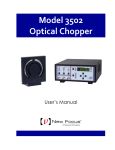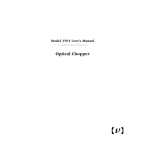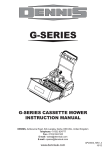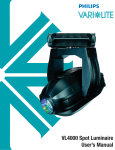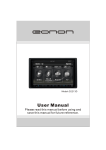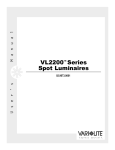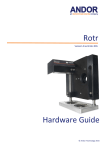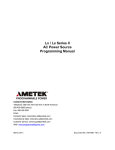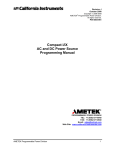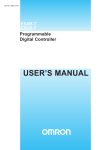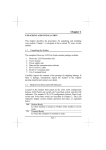Download 75160NF User`s Manual
Transcript
75160NF s ® Oriel Optical Chopper User's Manual Family of Brands – ILX Lightwave® • New Focus™ • Ophir® • Corion • Richardson Gratings™ • Spectra-Physics® M75160NF, Rev B 75160NF ORIEL OPTICAL CHOPPER Page 2 TABLE OF CONTENTS 1 2 3 4 SAFETY PRECAUTIONS .................................................................................................................... 4 1.1 SYMBOLS AND DEFINITIONS ............................................................................................. 4 1.2 GENERAL WARNINGS ......................................................................................................... 5 1.3 CAUTIONS ............................................................................................................................. 6 1.4 LOCATION OF LABELS AND WARNINGS ........................................................................... 6 INTRODUCTION .................................................................................................................................. 7 SYSTEM SETUP .................................................................................................................................. 8 3.1 ITEMS INCLUDED WITH SYSTEM ....................................................................................... 8 3.2 CHOOSING A LOCATION ..................................................................................................... 9 3.3 OPTIONAL RACK MOUNTING KIT ..................................................................................... 10 3.4 WHEEL INSTALLATION ...................................................................................................... 11 3.5 APERTURE INSTALLATION ............................................................................................... 13 3.6 MOUNTING THE CHOPPER HEAD .................................................................................... 14 3.7 ELECTRICAL AND COMPUTER CONNECTIONS ............................................................. 15 OPERATION ...................................................................................................................................... 17 4.1 SELF-TEST .......................................................................................................................... 17 4.2 WHEEL TYPE SELECTION ................................................................................................. 17 4.3 SYNCHRONIZATION OPTIONS ......................................................................................... 17 4.4 FREQUENCY LOCKING MODE .......................................................................................... 18 4.5 SYNC IN CONNECTOR....................................................................................................... 18 4.6 SYNTH OUT CONNECTOR ................................................................................................ 18 4.7 F OUTER CONNECTOR ..................................................................................................... 18 4.8 SET BUTTON....................................................................................................................... 18 4.8.1 4.8.2 4.8.3 4.8.4 4.8.5 4.8.6 5 6 Set: Set: Set: Set: Set: Set: FREQ .............................................................................................. 19 PHASE ............................................................................................ 19 H and S ........................................................................................... 19 STORE ............................................................................................ 19 RECALL .......................................................................................... 20 Default Settings ............................................................................... 20 4.9 MEASURE BUTTON ............................................................................................................ 20 4.10 UNLCK LED ......................................................................................................................... 20 4.11 USB LED .............................................................................................................................. 20 4.12 OUT 1 CONNECTOR........................................................................................................... 22 4.13 OUT 2 CONNECTOR........................................................................................................... 22 4.14 VEXT CONNECTOR .............................................................................................................. 22 4.15 MOTOR SOCKET ................................................................................................................ 22 4.16 USB 2.0 ................................................................................................................................ 22 4.17 POWER ENTRY MODULE .................................................................................................. 22 COMPUTER INTERFACE ................................................................................................................. 23 5.1 GENERAL INFORMATION .................................................................................................. 23 5.2 USING THE GRAPHICAL USER INTERFACE (GUI) ......................................................... 23 5.3 QUICK START GUIDE: USING THE CHOPPER APPLICATION ...................................... 24 5.4 USB COMMUNICATION ...................................................................................................... 24 5.5 COMMAND INDEX AND CONVENTIONS .......................................................................... 25 5.6 COMMAND DESCRIPTION ................................................................................................. 27 TROUBLESHOOTING ....................................................................................................................... 32 6.1 NORMAL STARTUP OPERATION ...................................................................................... 32 6.2 SYMPTOMS AND STEPS TO FOLLOW ............................................................................. 32 75160NF ORIEL OPTICAL CHOPPER Page 3 7 8 9 10 SPECIFICATIONS.............................................................................................................................. 33 7.1 CHOPPER CONTROLLER .................................................................................................. 33 7.2 CHOPPER WHEELS ........................................................................................................... 34 MAINTENANCE ................................................................................................................................. 35 8.1 ENCLOSURE CLEANING.................................................................................................... 35 8.2 wheel handling and storaGE ................................................................................................ 35 EU DECLARATION OF CONFORMITY............................................................................................. 36 WARRANTY AND SERVICE ............................................................................................................. 37 10.1 CONTACTING ORIEL INSTRUMENTS............................................................................... 37 10.2 REQUEST FOR ASSISTANCE / SERVICE......................................................................... 38 10.3 REPAIR SERVICE ............................................................................................................... 38 10.4 NON-WARRANTY REPAIR ................................................................................................. 38 10.5 WARRANTY REPAIR .......................................................................................................... 39 10.6 LOANER / DEMO MATERIAL .............................................................................................. 40 LIST OF FIGURES Figure 1: Rear Panel Labels and Warnings ................................................................................................. 6 Figure 2: Chopper Controller Dimensions ..................................................................................................... 9 Figure 3: Optional Rack Mounting Kit ........................................................................................................ 10 Figure 4: Chopper Wheel Selection ........................................................................................................... 11 Figure 5: Chopper Wheel Installation ......................................................................................................... 12 Figure 6: Maximum Beam Diameter .......................................................................................................... 13 Figure 7: Chopper Head Dimensions ......................................................................................................... 14 Figure 8: Connecting the Chopper Head to the Controller ........................................................................ 15 Figure 9: Summary of Modes, Settings and Outputs ................................................................................. 21 Figure 10: Optical Chopper Application Window ....................................................................................... 23 Figure 11: Summary of Computer Control Commands ............................................................................. 26 75160NF ORIEL OPTICAL CHOPPER Page 4 1 SAFETY PRECAUTIONS Thank you for your purchase of this Optical Chopper from Oriel Instruments. Please carefully read the following important safety precautions prior to unpacking and operating this equipment. In addition, please refer to the complete User’s Manual for additional important notes and cautionary statements regarding the use and operation of the system. Do not attempt to operate the system without reading all the information provided with each of the components. 1.1 SYMBOLS AND DEFINITIONS GENERAL WARNING OR CAUTION The Exclamation symbol in the figure above appears in Warning and Caution tables throughout this manual. This symbol indicates that you should read the associated documentation to determine the nature of any potential hazards and any actions that should be taken against these hazards. ELECTRICAL SHOCK The Electrical Shock symbol in the figure above appears throughout this manual. It indicates a hazard arising from dangerous voltage. Any mishandling could result in irreparable damage to the equipment, and personal injury or death. EUROPEAN UNION CE MARK The presence of the CE Mark on Oriel Instruments equipment means that this instrument has been designed, tested and certified compliant to all applicable European Union (CE) regulations and recommendations. ON The symbol in the figure above represents a power switch position on the Model 75160NF Optical Chopper Controller. This symbol represents a Power On condition. OFF The symbol in the figure above represents a power switch position on the Model 75160NF Optical Chopper Controller. This symbol represents a Power Off condition. WASTE ELECTRICAL AND ELECTRONIC EQUIPMENT (WEEE) This symbol on the product or its packaging indicates that the product must not be disposed with regular waste. It is the user’s responsibility to dispose of waste equipment marked with the WEEE Directive Symbol according to local laws. The separate collection and recycling of WEEE waste at the time of disposal will help conserve natural resources and ensure that it is recycled or disposed of in a manner that protects human health and the environment. For information about where the user can drop off WEEE waste for recycling, please contact your local Oriel Instruments representative. CONTROL OF HAZARDOUS SUBSTANCES This label indicates product compliance with the EU Directive 2002/95/EC that restricts the content of six particular hazardous substances. 75160NF ORIEL OPTICAL CHOPPER Page 5 Please read all instructions that were provided prior to operation of the system. If there are any questions, please contact Oriel Instruments or the representative through whom the system was purchased. 1.2 GENERAL WARNINGS Observe these general warnings when operating this equipment: • Thoroughly read and understand this User’s Manual. • Heed all warnings on the unit and in the operating instructions. • Use this equipment indoors only. • The external input power to this equipment can be up to 240 VAC. Please follow this User’s Manual for proper use or installation of this instrument. • Disconnect power before cleaning the equipment. Do not use liquid or aerosol cleaners; use only a damp lint-free cloth. • Lockout all electrical power sources before servicing the equipment. • There are no user-replaceable fuses in this equipment. The user must ensure that appropriate current-limiting protection is provided by the external AC power line. • Do not operate this equipment in an explosive or flammable atmosphere. • Use only the Oriel Instruments-supplied mains power cord with the external AC supply. Use of under-rated power cords may cause property damage. WARNING If this equipment is used in a manner not specified in this manual, the protection provided by this equipment may be impaired. WARNING These instruments is intended for use by qualified personnel who recognize thermal, shock, or laser hazards and are familiar with safety precautions required to avoid possible injury. Read this User’s Manual thoroughly before attempting to use the Model 75160NF Optical Chopper! CAUTION There are no user serviceable parts inside the Model 75160NF Optical Chopper Controller or Motor Head. Work performed by persons not authorized by Oriel Instruments will void the warranty. 75160NF ORIEL OPTICAL CHOPPER Page 6 1.3 CAUTIONS Observe these cautions when operating this equipment: • Thoroughly read and understand this User’s Manual. • If this equipment is used in a manner not specified in this manual, the protection provided by this equipment may be impaired. • Do not block ventilation openings. • Use only the specified replacement parts. • Follow precautions for static sensitive devices when handling this equipment. • This product should only be powered as described in the manual. • There are no user-serviceable parts inside the Model 75160NF Optical Chopper Controller or motor head. CAUTION The Model 75160NF Optical Chopper is designed to be safe when operated under Normal Environmental Conditions as defined in EN61010-1:2010. Operation under harsher environmental conditions can result in severe injury. The Model 75160NF Optical Chopper is intended for use in an industrial laboratory environment. Use of this product in other environments, such as residential, may result in electromagnetic compatibility difficulties due to conducted as well as radiated disturbances. 1.4 LOCATION OF LABELS AND WARNINGS The following is a photograph of the Model 75160NF Optical Chopper Controller rear panel. Figure 1: Rear Panel Labels and Warnings 75160NF ORIEL OPTICAL CHOPPER Page 7 2 INTRODUCTION The Model 75160NF Optical Chopper is used to introduce a periodic interruption of a light path in an optical experiment resulting in an amplitude modulation, which is useful for many small optical signal detection schemes. The modulation frequency can be controlled from 4 Hz to 10.65 kHz. Full control is available through the Model 75160NF Optical Chopper Controller’s front panel. In addition, the Chopper Controller can be programmed over a USB communication interface to set and measure the modulation frequency, adjust the interruption phase, and perform all other operations available through the front panel. A number of advanced features make the Model 75160NF Optical Chopper an excellent choice for many applications: • • • • Extremely low jitter noise across entire range of chopping frequencies Windows-based graphical user interface (GUI) User-written software control TM LabVIEW and C# examples Carefully read this User’s Manual before using the 75160NF Optical Chopper. Be especially careful to observe the warnings and cautions throughout this manual. If any operating instructions are not clear, please contact Oriel Instruments. This instruction manual contains the necessary information for operation and maintenance of the Model 75160NF Optical Chopper, as well as information for troubleshooting and obtaining service if necessary. 75160NF ORIEL OPTICAL CHOPPER Page 8 3 SYSTEM SETUP 3.1 ITEMS INCLUDED WITH SYSTEM The Model 75160NF Optical Chopper is carefully assembled, tested, and inspected before shipment. Upon receiving this instrument, check for any obvious signs of physical damage that might have occurred during shipment. Report any such damage to the shipping agent immediately. NOTE: Retain original packing materials in case reshipment becomes necessary. The 75160NF package contents: • Model 75160NF Optical Chopper Controller. • Model 75160NF Motor Assembly (including wheel cover) with a chopper head cable and a set of wheels with 2 apertures, 5 apertures, 12 apertures and 30 apertures. • USB Flash Drive containing this User Manual, USB driver, GUI software application and documented programming examples. • Power supply cables (North American and European). WARNING Do not attempt to operate this equipment if there is evidence of shipping damage or you suspect the unit is damaged. Damaged equipment may present additional hazards to you. Contact Oriel Instruments technical support for advice before attempting to plug in and operate damaged equipment. 75160NF ORIEL OPTICAL CHOPPER Page 9 3.2 CHOOSING A LOCATION Choose an installation location where the power requirements can be met for the system. Be sure power is not applied to the system until the setup has been completed. The environment should be that of a typical laboratory atmosphere, without excessive humidity and contaminants in the air. Do not allow the ventilation holes on the system’s components or its computer to be blocked. Air should be able to circulate freely around the system. Detailed environmental requirements are discussed in the Specifications section of this manual. Figure 2: Chopper Controller Dimensions 75160NF ORIEL OPTICAL CHOPPER Page 10 CAUTION Do not block the rear panel of the Controller. Ensure a minimum clearance of 30” for adequate ventilation of the device. Blocking the normal convective airflow around the unit, or thermally insulating the unit, can result in severe injury, damage to the product, and/or fire. 3.3 OPTIONAL RACK MOUNTING KIT The Model 3510 Rack Mount Kit is a Chopper accessory that allows one or two Chopper Controllers to be mounted in a standard rack. The kit consists of two short ears, one long ear, one rack plate, and six 6-32 flathead screws. The figure below illustrates how to use the rack mount kit to mount a single Chopper Controller or two Chopper Controllers side-by-side. The 3510 Rack Mount Kit consists of: • • • • Short Ears (quantity 2) Long Ear (quantity 1) Rack Plate (quantity 1) #6-32 Flat Head Screws (quantity 6) Figure 3: Optional Rack Mounting Kit 75160NF ORIEL OPTICAL CHOPPER Page 11 3.4 WHEEL INSTALLATION Select a chopper wheel to be installed based on the desired frequency and maximum allowable beam size. Number of Apertures 2 5 12 30 Frequency Range 4 to 140 Hz 25 to 350 Hz 60 to 800 Hz 150 to 2000 Hz Maximum Beam Size 32 mm 28 mm 13.7 mm 4.6 mm Figure 4: Chopper Wheel Selection To install a chopper wheel into the chopper head, first loosen the four (4) philips head screws that hold the cover; slide the cover off. Remove the three (3) socket head cap screws and the wheel hub washer from the center hub of the chopper head. 75160NF ORIEL OPTICAL CHOPPER Page 12 Figure 5: Chopper Wheel Installation Insert the chopper wheel in the gap of the photodetectors and reattach the hub washer and screws. Be sure to tighten the screws securely by inserting a screwdriver or similar item through the chopper aperture and back panel flange. This will prevent rotation of the chopper while tightening the hub screws. Please note that if a wheel is bent during the installation/removal process, it can be very difficult to straighten again. This may degrade the chopper controller’s stability of operation, and a replacement wheel may be required. Reattach the cover and tighten all cover screws. 75160NF ORIEL OPTICAL CHOPPER Page 13 3.5 APERTURE INSTALLATION The 75160NF includes three apertures of various diameters to limit the beam size to the maximum size allowed by the selected chopper wheel. These diameters match the maximum beam size allowable when selecting the 5, 12 or 20 aperture wheels. Select the appropriate aperture and install it per the following instructions. Note that an aperture is not used when installing the 2aperture wheel. The input flange acts as an aperture in that case. Wheel Aperture Required 2 Apertures none 5 Apertures 28 mm 12 Apertures 13.7 mm 30 Apertures 4.6 mm The enclosed chopper includes a set of apertures that match the beam size to the wheel aperture. The aperture is inserted into the female flange. Remove the pan head screw in the flange just above the motor, insert the proper aperture and replace the pan head screw to hold aperture in place. The correct aperture matches the maximum beam size. Note that the flange acts as the aperture for the two-aperture wheel. Figure 6: Maximum Beam Diameter 75160NF ORIEL OPTICAL CHOPPER Page 14 3.6 MOUNTING THE CHOPPER HEAD The Model 75160NF Optical Chopper Head may be secured to a standard optical rod using the #1/4-20 threaded hole. Remove the plug using a hex head wrench to access the threaded hole. The Chopper Head may also be mounted to standard 1.5-inch Oriel components. One end of the chopper has a male flange, and the other a female flange. Either flange may be considered the input side. Install the chopper head in the desired location. The chopper head may be rotated in whichever direction is most convenient for connecting the cable to the chopper controller. Figure 7: Chopper Head Dimensions WARNING The moving wheel may inflict injury. The chopper head should never be operated without the cover in place. 75160NF ORIEL OPTICAL CHOPPER Page 15 3.7 ELECTRICAL AND COMPUTER CONNECTIONS Insert one end CBL-75160NF cable to the back of the chopper controller at the connector labeled “MOTOR”. Connect the other end of the CLB-75160NF cable to the chopper head and secure it using the screws included with the cable. The Model 75160NF Optical Chopper Controller can be connected to a computer with a standard USB-A to USB-B cable for computer control and communication. Figure 8: Connecting the Chopper Head to the Controller WARNING To avoid electric shock, connect the instrument to building earthground, 3-prong receptacles by using the supplied power cord only. Failure to observe this precaution can result in damage to the product, fire, severe injury, or death. WARNING Do not position this product in such a manner that would make it difficult to disconnect the power cord. 75160NF ORIEL OPTICAL CHOPPER Page 16 WARNING Position the equipment so that access to the mains ON/OFF switch is readily available. In the event of a hazard, press the grey Power switch on the lower right of the front panel to the OFF position to turn power OFF to the internal electronics and fully disconnect the power cord of the Controller from mains power. Verify the electrical mains meets the requirements noted on the back of the chopper controller. If necessary, consult a qualified electrician to ensure the electrical mains is compatible with the operation of this equipment. Make sure that that power switch is in the OFF position. Insert the power cable into the back of the controller and then connect it to the electrical mains. Power up the controller by depressing the Power switch on the front of the unit, and then adjust the operating parameters as desired. 75160NF ORIEL OPTICAL CHOPPER Page 17 4 OPERATION 4.1 SELF-TEST When the unit is turned on the unit performs a series of internal verifications, the word PASS is briefly displayed on the 5-digit LED numeric display, and it shows its driving frequency set point. The unit is then ready to operate the Chopper Head. 4.2 WHEEL TYPE SELECTION The Model 75160NF Optical Chopper can be operated manually by keying in control functions from the Chopper Controller front panel shown below. Fouter is the chopping frequency as measured by an optical pick-up on the Model 75160NF Optical Chopper Head. To change the wheel type, push the Wheel button until the LED lights under the desired wheel type. Using the WHEEL button on the chopper controller, set the wheel type to match the frequency range desired. To change the wheel type, push the Wheel button until the LED lights under the desired wheel type. Wheel Type 2 = 4 Hz to 213 Hz Wheel Type 60 = 120 Hz to 2.4 kHz 4.3 SYNCHRONIZATION OPTIONS The user may synchronize the chopping frequency to the Chopper's internal synthesizer (INT), the rising edge (EXT+) or falling edge (EXT-) of an externally supplied signal on Sync In. The motor’s rotational speed may be controlled directly by applying a negative voltage to the Vext input. When INT is selected, the signals available on the OUT 1 and OUT 2 outputs (see the following section on the Mode button) on the back panel are phase-locked to the internal synthesizer. When using the INT setting, a signal applied to Sync In has no effect on the device’s operation. When an external signal is used, either with EXT+ or EXT-, the signals available on the OUT 1 and OUT 2 outputs are instead phase-locked to the external signal. In EXT+ and EXT- modes, the output from Synth Out (described below) is not locked to, and does not have the same frequency as, the external signal and remains at the frequency set point set on the front panel. When Vext is selected, the user may drive the motor directly with an analog voltage (-10 V to 0 V) applied at Vext on the back panel. When using Vext or INT, a signal applied to the Sync In input has no effect on the Chopper. In this setting, the signals available on OUT 1 and OUT 2 are frequencyand phase-locked to the chopping frequency measured using the photo-interrupt on the Chopper Head, Fouter. Note that these signals will therefore only be as stable as the externally controlled chopping frequency. To change the Sync source, press the Sync button until the LED under the desired Sync source lights. 75160NF ORIEL OPTICAL CHOPPER Page 18 4.4 FREQUENCY LOCKING MODE The Mode button allows the User to change the frequency that Fouter will lock to in addition to the reference signals available at OUT 1 and OUT 2 (rear panel). The table below gives the locking frequency of Fouter and the reference signals available at OUT 1 and OUT 2, for each Mode setting. When the Sync setting is Vext, the reference signals available at OUT 1 and OUT 2 are generated with respect to the measured chopping signal Fouter. To change the Mode, push the Mode key until the LED under the desired selection lights up. In the table, the following definitions are used: Fsync: frequency of the Sync source Fouter: chopping frequency of outer slots as measured by IR sensor Finner: this function is not used with Oriel chopper wheels 4.5 Mode Setting Fouter locked to OUT 1 OUT 2 H/S (H/S)⋅FSync (H/S)⋅Fsync [H/(7⋅S)]⋅Fsync +/- Fsync Fouter – Finner Fouter + Finner Normal Fsync 5⋅Fsync Finner SYNC IN CONNECTOR A TTL signal applied to the Sync In input will be used as a frequency and phase reference in EXT+ and EXT- modes. TTL pulses can be used to trigger the Chopper Controller as long as they are longer than 1 μs. 4.6 SYNTH OUT CONNECTOR The signal provided by the internal synthesizer is available on this output. 4.7 F OUTER CONNECTOR The signal from the optical pick-up on the Chopper Head is available on this output as a TTL signal. 4.8 SET BUTTON The Set button selects which instrument parameter you can modify using the cursor keys. Press Set until the LED lights under the desired parameter: FREQ, PHASE, H, S, RECALL, or STORE. Each of these parameters is described below. The up arrow and down arrow keys will then change the parameter value. In some cases, the left arrow and right arrow keys select the significant digit to be modified. 75160NF ORIEL OPTICAL CHOPPER Page 19 4.8.1 Set: FREQ The user may set the internal synthesizer frequency depending on the Sync source selected. When EXT-, EXT+ or Vext sync has been selected, the frequency may range from 4.00 Hz to 2.00 kHz. When the INT setting is selected for the Sync source, the synthesizer frequency will be restricted to the working range of the particular chopping wheel. In H/S mode this range will be modified by the user-specified values of H and S according to: Fmax = (S/H)•Fouter, highest and Fmin = (S/H)•Fouter, lowest The internal synthesizer frequency may be set to three significant digits. The significant digit to be modified may be selected by the left and right arrow keys. The magnitude of the digit may be changed with the up and down arrow keys. If the display overflows or underflows, the display will change between the Hz/kHz LEDs and move the decimal point to maintain three significant digits of resolution. 4.8.2 Set: PHASE The phase delay may be set from -180.0° to +179.0°. The phase shift is always with respect to Fouter. In NORMAL and +/- modes, Fouter = Fsync. In H/S mode Fouter = (H/S)•Fsync. When the phase adjustment is active, the DEG LED will be lit. The left and right arrow keys can be used to select the significant digit to modify, and this digit will blink. The up and down arrow keys can be used to change the magnitude of the digit. 4.8.3 Set: H and S In H/S mode the user may lock the Chopper to a harmonic of the sync frequency. H is set to the harmonic of interest. Use the up arrow and down arrow keys to set H to an integer value from 1 to 15. The user may lock the Chopper to a subharmonic of the sync frequency. S is set to the subharmonic of interest. Use the up arrow and down arrow keys to set S to an integer value from 1 to 15. S and H may be set in any combination. 4.8.4 Set: STORE The user may store an instrument setup in one of two ways. First, the control unit will retain the control settings when the power is removed. When power is restored, the instrument will recall the last control settings used. Second, the user may utilize one of nine programmable instrument set-ups. To store an instrument setup press the Set button until STORE is lit. Then, use the up and down arrow keys to assign the instrument setup number, 1-9. Press the left or right arrow key to store the instrument’s settings. Location 0 is reserved for the factory default settings (see the Default Settings section below). 75160NF ORIEL OPTICAL CHOPPER Page 20 4.8.5 Set: RECALL The user may recall an instrument setup in one of two ways. Firstly, on power up, the instrument will recall the last control settings used. Secondly, a previously stored setup can be recalled by pressing the Set button until the RECALL LED is lit. The up and down arrow keys are used to select the instrument setup number, again, ranging from 0 to 9. Press the left or right arrow key to recall the displayed instrument setup. The display will blink when the recall process is complete. Location 0 is reserved for the factory default settings. 4.8.6 Set: Default Settings Location 0 is reserved for the factory default settings: Wheel is set to 42/30, Sync is set to INT, Mode is set to NORMAL, and the internal synthesizer frequency is set to 84 Hz. 4.9 MEASURE BUTTON The Measure button is used to select which frequency measurement (Fsync, Fouter, OUT 1 or OUT 2) is displayed on the front panel. The instrument will continue to measure and update the display until another function key is pressed. To change the parameter to be measured, press the Measure button until the LED lights under the desired parameter. 4.10 UNLCK LED The red UNLCK LED indicates when the Chopper is not synchronized to an internal or external sync frequency. In addition, the UNLCK LED will blink when an external sync frequency exceeds the limits for a particular wheel. 4.11 USB LED The USB LED lights when the Chopper Controller is connected to a computer. 75160NF ORIEL OPTICAL CHOPPER Page 21 OUT 1 Mode Phase Sync Source OUT 2 Output Freq. is locked Fouter Phase Output Freq. to is locked Output Freq. Phase is locked to to Int 5·(Int. Fsync) Int. Fsync (5/7)·(Int. Fsync) Int. Fsync Int. Fsync Int. Fsync Ext+, Ext- 5·(Ext. Fsync) Ext. Fsync (5/7)·(Ext. Fsync) Ext. Fsync Ext. Fsync Ext. Fsync Vext 5·(Fouter) Fouter (5/7)·( Fouter) Fouter Freq. is controlled by ext. voltage. Motor phase is not controlled internally. Int. Fsync Int. Fsync Int. Fsync 1 Normal (2/7)·(Int. Fsync) Int i.e. Fouter - Finner with Fouter = (7/5)·Finner (12/7)·(Int. Fsync) Int. Fsync (2/7)·(Ext. Fsync) +/- (12/7)·(Ext. Fsync) 1 Ext+, Ext- i.e. Fouter - Finner with Fouter = (7/5)·Finner Ext. Fsync i.e. Fouter + Finner with Fouter = (7/5)· Finner Ext. Fsync Ext. Fsync Ext. Fsync Vext (2/7)·(Fouter) Fouter (12/7)·( Fouter) Fouter Freq. is controlled by ext. voltage. Motor phase is not controlled internally. Int (H/S)·(Int. Fsync) Int. Fsync (H/7S)·(Int. Fsync) Int. Fsync (H/S)·(Int. Fsync) Int. Fsync Ext+, Ext- (H/S)·(Ext. Fsync) Ext. Fsync (H/7S)·(Ext. Fsync) Ext. Fsync (H/S)·(Ext. Fsync) Ext. Fsync Vext (H/S)·(Fouter) Fouter (H/7S)·( Fouter) Fouter Freq. is controlled by external voltage. Motor phase is not controlled internally. 1 H/S i.e. Fouter + Finner with Fouter = (7/5)· Finner Figure 9: Summary of Modes, Settings and Outputs 75160NF ORIEL OPTICAL CHOPPER Page 22 4.12 OUT 1 CONNECTOR The function of the OUT 1 output depends on the instrument’s operating mode. In H/S mode, the instrument provides a TTL-level signal at frequency (H/S)•Fsync. In +/- mode the frequency at OUT 1 is Fouter - Finner, and in NORMAL mode the frequency is 5•Fouter. 4.13 OUT 2 CONNECTOR The function of the OUT 2 output depends on the instrument’s operating mode. In H/S mode, the instrument provides the user with a TTL-level signal at frequency [H/(7•S)] •Fsync. The +/- mode is not applicable. In NORMAL mode the frequency is Finner. 4.14 VEXT CONNECTOR The Vext BNC input connector can be used to supply an external 0 to -10 V DC voltage. When the Sync setting is Vext, the user may drive the Chopper motor directly with this input DC voltage. In this case, 0 to -10 V DC corresponds to 0 to 100% of the highest motor speed, respectively. 4.15 MOTOR SOCKET The input marked MOTOR on the rear panel is used to connect the 75160NF Optical Chopper Head to the Chopper Controller with the cable provided. 4.16 USB 2.0 The USB-B input port is used in connecting the Chopper Controller to a host computer system. This allows the instrument to be controlled remotely via USB interface. 4.17 POWER ENTRY MODULE The AC power is connected at the power entry module on the rear panel. The power module has been chosen for global operation, and North American and European power cords are supplied. 75160NF ORIEL OPTICAL CHOPPER Page 23 5 COMPUTER INTERFACE 5.1 GENERAL INFORMATION The Model 75160NF Optical Chopper can be controlled remotely over the USB 2.0 interface either via an intuitive, Windows-based Graphical User Interface (GUI) application or via commands sent from a host PC. This control functionality is identical to the New Focus model 3502 Chopper Controller, which functions with different chopper wheels and chopper head. Before connecting the instrument to the USB interface the user should install the application included on the flash drive that accompanies the Model 75160NF Optical Chopper. The installer will install not only the GUI application, but also the appropriate USB drivers and programming examples (LabVIEW and C#), and supporting documentation. Please consult the ‘Readme Chopper Application.pdf’ document on the flash drive for installation instructions and a list of the files that are installed. This document also addresses important considerations when installing the software on 32-bit or 64-bit operating systems. Although the user may choose a custom installation directory, the default location is under ‘Program Files\New Focus\New Focus Chopper Application\’. Three sub-directories are installed here: ‘Bin’, containing the Chopper Application and supporting files; ‘Docs’, containing documentation of the GUI Application, the programming examples and the Newport USB library API documentation; and ‘Samples’, containing C# and LabVIEW examples to get started with remote operation of the Model 75160NF Optical Chopper. Please note that these examples are provided for reference only. 5.2 USING THE GRAPHICAL USER INTERFACE (GUI) The GUI allows full control of the Model 75160NF Optical Chopper’s front panel functions (save for turning the Controller On/Off). Figure 10: Optical Chopper Application Window 75160NF ORIEL OPTICAL CHOPPER Page 24 5.3 QUICK START GUIDE: USING THE CHOPPER APPLICATION 1. Turn the Model 75160NF Optical Chopper Controller on using the power button on the front panel of the Controller. 2. Open the Oriel Instruments Chopper Application. If you turn on the Chopper after opening the application you may need to select the Connect menu item from the File menu. 3. The icon at the lower left corner of the window indicates that the GUI has successfully established a connection to the Chopper Controller. 4. Operating parameters can now be set from the application window: radio buttons are used to select the Wheel, Sync mode, and Mode of operation. 5. The desired chopping frequency is set by entering the value in Hz in the topmost text entry field and pressing the Set Freq button. Similarly, the chopping phase, H, and S can all be changed. Note that although you can set values for the chopping frequency, phase, H, and S via the GUI, the present values of these set points can only be read through the front panel of the Chopper Controller. 6. Up to nine setup states can be stored using the Store button on the left. This is done by first assigning the setup state a number (1-9) from the dropdown menu next to the Store button, then clicking the button. Similarly, a setup state can be recalled using the Recall button. 7. The frequency of Sync In, Fouter, OUT 1, and OUT 2 can be measured by clicking their respective button in the Measure field. The magnitude of the frequency measured (in Hz) will be shown in the numeric display field. 8. To exit the application, either close the window or select ‘Exit’ from the ‘File’ menu. 5.4 USB COMMUNICATION To control the Model 75160NF Optical Chopper remotely without using the GUI application, commands can be issued directly over USB using the Newport USB library. The API is described in detail in the document ‘Chopper USB Libraries API User’s Manual.pdf’. This file is installed in the ‘Docs’ folder. After consulting this document, the best way to become acquainted with the procedure for controlling the Model 75160NF Optical Chopper programmatically is to review the provided C# and LabVIEW examples. 75160NF ORIEL OPTICAL CHOPPER Page 25 5.5 COMMAND INDEX AND CONVENTIONS In the brief command index below and detailed command descriptions that follow in the next subsection several conventions are used. Some commands may be used to set and query an operating parameter. For example, the PHS command can be used to set the chopping phase (PHS900) or to read the value of the phase (PHS?). If a command allows querying, it will be followed by a ‘?’. If a command is not a query, there will be no response from the Chopper Controller. A bracket pair ‘[ ]’ indicates that the command accepts a data value. Data ranges are given in parentheses ‘( )’. Do not use a decimal point or comma in data passed to the Chopper Controller this way. For example, to set the chopping frequency to 1.23 kHz, send the command OSC123000. To set the phase to -90 degrees, send the command PHS-90. Note that data returned from the Controller will have decimal points included. 75160NF ORIEL OPTICAL CHOPPER Page 26 Multiple commands on a single line must be separated by a semicolon ‘;’. Measures a given frequency. FR*? HAR[ ]? IDN? 1 = Fsync, 2 = Fouter, 3 = OUT 1, 4 = OUT 2. Sets the harmonic multiplier H (1 - 15). Identification query. Returns “ORIEL INSTRUMENTS 75160NF CHOPPER <Firmware version> <Firmware date>, SN<Serial Number>”. Duplicates the action of pressing a front panel key: KEY* MEM* 0 = Right arrow, 1 = Down arrow, 2 = Up arrow, 3 = Left arrow, 4 = Set, 5 = Measure, 6 = Mode, 7 = Sync, 8 = Wheel. Accesses instrument set-up memory. 0 = Store, 1 = Recall. Use with STO and RCL commands. MOD*? Selects the instrument mode. 0 = H/S, 1 = +/-, 2 = NORMAL. OSC[ ]? Sets the internal synthesizer frequency to three significant digits. (4 Hz to 2.00 kHz in EXT+/EXT- mode; range automatically limited in INT mode). PHS[ ]? Sets the phase delay (-180.0 to +179.0). RCL[ ]? Selects instrument set-up for recall (0 - 9). 0 - factory default set-up. Use with MEM1 command. SET* Selects the parameter modified by the arrow keys: 0 - Synth frequency, 1 Phase, 2 - Harmonic multiplier, 3 - Subharmonic divisor, 4 - Recall set-up, 5 Store set-up STO[ ]? Selects instrument set-up for storage (1-9). Use with MEM command. SUB[ ]? Sets subharmonic divide ratio S (= 1 - 15). SYN[ ]? Selects the source of the sync frequency. 0 = Vext, 1 = EXT+, 2 = EXT-, 3 = INT. WHL*? Selects the wheel. 0 = type 60, 3 = type 2 Figure 11: Summary of Computer Control Commands 75160NF ORIEL OPTICAL CHOPPER Page 27 5.6 COMMAND DESCRIPTION FR*? Description Frequency query. Syntax FR*? Remarks The FR* command is used to query the following frequencies associated with the Measure key on the Chopper front panel: Fsync, Fouter, OUT 1, and OUT 2. Data is returned in Hz. FR1? Query Fsync FR2? Query Fouter FR3? Query frequency of OUT 1 FR4? Query frequency of OUT 2 Example The chopping frequency is 1.25 kHz at OUT 1, and the Chopper is in NORMAL mode. Query FR3? Response FR31250.0 HAR[ ]? Description Set and query H. Syntax HAR[ ]? Remarks The HAR command sets and queries the harmonic multiplier H, which is used in H/S mode. The data may range from 1 to 15. Example H is currently set to 2. Command HAR2 Query HAR? Response HAR2 Sets H to 2. H is currently set to 2. IDN? Description Identification query. Syntax IDN? Remarks Returns the following string identifying the Chopper: " NEW FOCUS 3502 CHOPPER <Firmware version> <Firmware date>, SN<Serial Number>". Example The instrument is model 75160NF, serial number P0004, firmware version 1.16 dated 05/05/2014. Query IDN? Response NEW FOCUS 3502 CHOPPER 1.16 5/05/14, SNP0004 75160NF ORIEL OPTICAL CHOPPER Page 28 KEY? Description Duplicates the action of pushing a front panel button. Syntax KEY? Remarks The KEY command duplicates the action of pushing one of the 9 black front panel buttons. The nine options are as follows: KEY0 Right arrow KEY1 Down arrow KEY2 Up arrow KEY3 Left arrow KEY4 Set KEY5 Measure KEY6 Mode KEY7 Sync KEY8 Wheel MEM? Description Store and recall instrumental set-ups. Syntax MEM? Remarks The MEM command, along with the STO and RCL commands, is used to store and recall one of the 9 instrumental set-ups. After selecting which instrument setup number to use (1 through 9) using the STO command, MEM0 will store the current instrument set-up. After selecting which instrument set-up to recall using the RCL command, MEM1 recalls the selected set-up. Example STO5 Selects location #5 for setup storage MEM0 Saves setup in location #5 RCL1 Selects location #1 setup recall MEM1 Recalls setup in location #1 MOD*? Description Select and query the mode of operation. Syntax MOD*? Remarks The MOD command allows the user to query the Chopper’s operating mode and to set the Chopper operating mode as follows: MOD0 H/S MOD1 +/- MOD2 NORMAL 75160NF ORIEL OPTICAL CHOPPER Page 29 Example Command MOD2 Query MOD? Response MOD2 Sets operating mode to NORMAL. Operating mode is NORMAL. OSC[ ]? Description Set and query the synthesizer frequency. Syntax OSC[ ]? Remarks The OSC command sets and queries the internal synthesizer. In INT Sync mode setting the synthesizer frequency will set the chopping frequency. In INT Sync mode the data supplied by the OSC command is limited by the Chopper wheel minimum and maximum chopping frequencies. In the other modes of operation, the data may range from 4.00 to 99.9 kHz. Only three digits of resolution are available. The data is entered in Hz, and no decimal point should be included. Example Command OSC54300 Query OSC? Response OSC543.00 Sets the internal synthesizer to 543 Hz. The internal synthesizer’s frequency is set to 543 Hz. PHS[ ]? Description Set and query the phase delay. Syntax PHS[ ]? Remarks The PHS command sets and queries the phase shifter. The data may range from -180.0 to +179.0 degrees. Do not use a decimal point in the data. Example Command PHS-1234 Query PHS? Response PHS-123.4 The phase shift is set to -123.4 degrees. Command PHS222 Sets the phase shift to 22.2 degrees. Sets the phase shift to -123.4 degrees. RCL[ ]? Description Selects instrument set-up for recall. Syntax RCL[ ]? Remarks The RCL command will select a formerly stored instrument set-up. The RCL? query will return the recall set-up number. The data may range between 0 and 9. Recall of set-up “0” will restore the Model 75160NF Optical Chopper to factory default settings. RCL is used with MEM1 to recall the instrument set-up. Example Command RCL0 Selects factory default setup for recall. Command MEM1 Recalls factory default setup. 75160NF ORIEL OPTICAL CHOPPER Page 30 RCL4 Command. Select location #4 for setup recall. Query RCL? Response RCL4 The active location for recall is location #4. Command MEM1 Recalls setup in location #4. SET* Description Selects the parameters to be modified by the arrow keys. Syntax SET* Remarks The SET command selects which parameter is activated so that it can be changed by the arrow keys. SET0 Synthesizer frequency SET1 Phase SET2 H SET3 S SET4 Recall SET5 Store STO[ ]? Description Selects instrument set-up for storage. Syntax STO[ ]? Remarks The STO command selects the instrument set-up number in which to store the current Chopper set-up. The STO? query will return the selected instrument set up number. The data may range from 1 to 9. STO is used with MEMO to store the instrument set-up. Example Command STO9 Query STO? Response STO9 Location #9 is selected for setup recall. MEM0 Recalls setup #9. Command Selects location #9 for setup storage. SUB[ ]? Description Set and query S. Syntax SUB[ ]? Remarks The SUB command sets and queries S, the subharmonic divide ratio which is used in H/S mode. The data may range from 1 to 15. Example Command SUB7 Query SUB? Sets subharmonic divide ratio to 7. 75160NF ORIEL OPTICAL CHOPPER Page 31 Response SUB7 Subharmonic divide ratio is 7. SYN[ ]? Description Set and query the source used for synchronization. Syntax SYN[ ]? Remarks The SYN command sets and queries the frequency source used for synchronization. SYN0 Vext SYN1 Ext+ SYN2 ExtSYN3 INT SYN? Query Example Command SYN3 Sets sync source to INT. Query SYN? Response SYN3 Sync source is set to INT. WHL[ ]? Description Set and query the type of chopping wheel being used. Syntax WHL[ ]? Remarks The WHL command sets and queries the type of chopping wheel that is being used: WHL0 120 Hz to 2.0 kHz WHL2 4 Hz to 213 Hz WHL? Query wheel type Example Command WHL2 Query WHL? Response WHL2 Selects the type 2 wheel. Wheel Type 2 is selected. 75160NF ORIEL OPTICAL CHOPPER Page 32 6 TROUBLESHOOTING 6.1 NORMAL STARTUP OPERATION When the Chopper Controller is properly connected to the power mains and a Chopper Head, and is turned on, the front panel LEDs will blink and the display will show PASS before recalling the last Chopper Controller set up. The motor should begin turning and come to speed within about one minute. 6.2 SYMPTOMS AND STEPS TO FOLLOW If nothing happens: Check that the power cord is connected to the Chopper Controller. Check that the Chopper Head is connected to the Chopper Controller. Do not connect the Chopper Head when the Chopper Control unit is powered on. Fails test at start up: Please contact Oriel Instruments for service. Motor fails to turn: With power removed from the control unit, check that the wheel is free to turn without obstructions. Also, this condition may be caused by a broken shielded Ethernet cable between the Chopper Controller and the Chopper Head. Substitution of a known functional shielded Ethernet cable is the best solution. Motor spins down and stops when sync frequency is changed: The Chopper Controller will stop driving the motor in the Chopper Head if an externally-supplied sync frequency is outside the range of the chopping frequencies allowed for a given wheel setting. Verify that this external signal is of the correct frequency. Synchronization to an external signal is unreliable: Verify that the pulse width of the external trigger pulse is at least 1 μs long. Use an oscilloscope with a high impedance input to monitor the external signal while it is connected to the Chopper Controller. The input signal should have valid TTL voltage levels. Motor frequency oscillates: Recall the factory default settings. This will place the instrument into known conditions. If the oscillation stops, then the signal supplied via Sync In may have been unstable. Verify the stability of the input signal with an oscilloscope or frequency counter. The frequency of the signal on Sync In may have been outside of operating limits which are determined by the operating Mode, H, S, and the Wheel setting. Refer to the entry on the FREQ setting in Section Error! Reference source not found. on page Error! Bookmark not defined. for more details. Observe the signal at Fouter on an oscilloscope. If the cable or optical sensor is damaged, the signal will remain high or low. If this is the case, replace the cable between the Chopper Controller and the Chopper Head. Check for the correct wheel setting on the front panel. 75160NF ORIEL OPTICAL CHOPPER Page 33 7 SPECIFICATIONS 7.1 CHOPPER CONTROLLER INTERNAL SYNTHESIZER Parameter Specification Stability Drift Accuracy Resolution Range limits (EXT) 100 ppm after one hour warm-up Less than 10 ppm/°C < 1/5 of least significant digit 3 significant digits 4 Hz to 2.00 kHz REFERENCE INPUT Input Type Frequency Limit Pulse width Sync InTTL-level pulse Same as internal oscillator ≥ 1 μs REFERENCE OUTPUT TTL level square wave May be used as free-running oscillator when using EXT+, EXT- or Vext Sync setting TTL-level square wave at the chopping frequency TTL level pulse: 5*Fouter in NORMAL mode (H/S)*Fouter in H/S mode TTL level pulse: [H/(7•S)]*Fsync in H/S mode Sync Out Fouter OUT 1 OUT 2 PHASE SHIFTER Range Resolution -180.0° to +179.0° 0.1°, increasing to 0.25° at 2.0 kHz HARMONIC LOCKING Harmonic (H) 1 to 15 Subharmonic (S) 1 to 15 Note: H and S may be set in any combination. EXTERNAL VOLTAGE CONTROL Voltage Control Range 0 to 10.0 VDC 0 to 100% of maximum chopping frequency GENERAL Net Weight Electrical Ratings Operating Environment Storage Environment Altitude Pollution Degree 2.59 kg [5.7 lbs], including chopper head 100 to 240 VAC, 50 to 60 Hz 25 Watts 10°C to 40°C [50°F to 104°F] ≤ 90% humidity, non-condensing 0°C to 50°C [32°F to 122°F] ≤ 90% humidity, non-condensing < 3000 meters [10000 feet] 2 75160NF ORIEL OPTICAL CHOPPER Page 34 7.2 CHOPPER WHEELS CHOPPER WHEELS Wheel Model Description 75162 2 Aperture Wheel 75163 5 Aperture Wheel 75166 12 Aperture Wheel 75164 30 Aperture Wheel Minimum Frequency, Jitter 4 Hz, 1900 μs 25 Hz, 560 μs 60 Hz, 540 μs 150 Hz, 150 μs Maximum Frequency, Jitter 140 Hz, 2.5 μs 350 Hz, 1.28 μs 800 Hz, 1.0 μs 2.0 kHz, 0.6 μs Maximum Beam Diameter 1.26 in [32.0 mm] 1.06 in [27.0 mm] 0.43 in [11.0 mm] 0.18 in [4.5 mm] 75160NF ORIEL OPTICAL CHOPPER Page 35 8 MAINTENANCE 8.1 ENCLOSURE CLEANING Before cleaning the enclosure of the Model 75160NF Optical Chopper Controller, the power cord must be disconnected from the wall socket and from the unit. The source enclosure should only be cleaned with a mild soapy water solution applied to a damp lint-free cloth. Do not use an acetone or alcohol solution; this will damage the finish of the enclosure. 8.2 WHEEL HANDLING AND STORAGE Wheels should be handled with care and stored flat where they cannot become bent. If a wheel is bent, the ability of the controller to lock onto the frequency may be compromised. It is very difficult to straighten a bent wheel, so a replacement may be ordered. 75160NF ORIEL OPTICAL CHOPPER Page 36 9 EU DECLARATION OF CONFORMITY We declare that the accompanying product, identified with the mark, complies with requirements of the Electromagnetic Compatibility Directive, 2014/30/EU and the Low Voltage Directive 2006/95/EC. Model Number: 75160NF Year mark affixed: 2015 Type of Equipment: Electrical equipment for measurement, control and laboratory use in industrial locations. Manufacturer: Newport Corporation 1791 Deere Avenue Irvine, CA 92606 Standards Applied: Compliance was demonstrated to the following standards to the extent applicable: BS EN61326-1: 2013 “Electrical equipment for measurement, control and laboratory use – EMC requirements” for use in a controlled electromagnetic environment. This equipment meets the EN55011:2009+A1:2010 Class A Group 1 radiated and conducted emission limits. BS EN 61010-1:2010, “Safety requirements for electrical equipment for measurement, control and laboratory use”. Mark Carroll Sr. Director, Instruments Business Newport Corporation 1791 Deere Ave, Irvine, CA92606 USA 75160NF ORIEL OPTICAL CHOPPER Page 37 10 WARRANTY AND SERVICE 10.1 CONTACTING ORIEL INSTRUMENTS Oriel Instruments belongs to Newport Corporation's family of brands. Thanks to a steadfast commitment to quality, innovation, hard work and customer care, Newport is trusted the world over as the complete source for all photonics and laser technology and equipment. Founded in 1969, Newport is a pioneering single-source solutions provider of laser and photonics components to the leaders in scientific research, life and health sciences, photovoltaics, microelectronics, industrial manufacturing and homeland security markets. Newport Corporation proudly serves customers across Canada, Europe, Asia and the United States through numerous international subsidiaries and sales offices worldwide. Every year, the Newport Resource catalog is hailed as the premier sourcebook for those in need of advanced technology products and services. It is available by mail request or through Newport's website. The website is where one will find product updates, interactive demonstrations, specification charts and more. To obtain information regarding sales, technical support or factory service, United States and Canadian customers should contact Oriel Instruments directly. Newport - Oriel Instruments 1791 Deere Avenue Irvine, CA 92606 USA Telephone: 800-222-6440 (toll-free in United States) 949-863-3144 Fax: 949-253-1680 Sales: [email protected] Technical assistance: [email protected] Repair Service: [email protected] Customers outside of the United States must contact their regional representative for all sales, technical support and service inquiries. A list of worldwide representatives can be found on Oriel's website: http://www.newport.com/oriel. 75160NF ORIEL OPTICAL CHOPPER Page 38 10.2 REQUEST FOR ASSISTANCE / SERVICE Please have the following information available when requesting assistance or service: Contact information for the owner of the product. Instrument model number (located on the product label). Product serial number and date of manufacture (located on the product label). Description of the problem. To help Oriel's Technical Support Representatives diagnose the problem, please note the following: Is the system used for manufacturing or research and development? What was the state of the system right before the problem? Had this problem occurred before? If so, when and how frequently? Can the system continue to operate with this problem, or is it non-operational? Were there any differences in the application or environment before the problem occurred? 10.3 REPAIR SERVICE This section contains information regarding factory service for this product. The user should not attempt any maintenance or service of the system beyond the procedures outlined in this manual. This product contains no user serviceable parts other than what is noted in this manual. Any problem that cannot be resolved should be referred to Oriel Instruments. If the instrument needs to be returned for service, a Return Material Authorization (RMA) number must be obtained prior to shipment to Oriel Instruments. This RMA number must appear on both the shipping container and the package documents. Return the product to Oriel Instruments, freight prepaid, clearly marked with the RMA number and it either will be repaired or replaced it at Oriel's discretion. Oriel is not responsible for damage occurring in transit. The Owner of the product bears all risk of loss or damage to the returned Products until delivery at Oriel's facility. Oriel is not responsible for product damage once it has left the facility after repair or replacement has been completed. Oriel is not obligated to accept products returned without an RMA number. Any return shipment received by Oriel without an RMA number may be reshipped by Newport, freight collect, to the Owner of the product. 10.4 NON-WARRANTY REPAIR For Products returned for repair that are not covered under warranty, Newport's standard repair charges shall be applicable in addition to all shipping expenses. Unless otherwise stated in Newport's repair quote, any such out-of-warranty repairs are warranted for ninety (90) days from date of shipment of the repaired Product. Oriel will charge an evaluation fee to examine the product and determine the most appropriate course of action. Payment information must be obtained prior to having an RMA number assigned. Customers may use a valid credit card, and those who have an existing account with Newport Corporation may use a purchase order. 75160NF ORIEL OPTICAL CHOPPER Page 39 When the evaluation had been completed, the owner of the product will be contacted and notified of the final cost to repair or replace the item. If the decision is made to not proceed with the repair, only the evaluation fee will be billed. If authorization to perform the repair or provide a replacement is obtained, the evaluation fee will be applied to the final cost. A revised purchase order must be submitted for the final cost. If paying by credit card, written authorization must be provided that will allow the full repair cost to be charged to the card. 10.5 WARRANTY REPAIR If there are any defects in material or workmanship or a failure to meet specifications, notify Oriel Instruments promptly, prior to the expiration of the warranty. Except as otherwise expressly stated in Oriel's quote or in the current operating manual or other written guarantee for any of the Products, Oriel warrants that, for the period of time set forth below with respect to each Product or component type (the "Warranty Period"), the Products sold hereunder will be free from defects in material and workmanship, and will conform to the applicable specifications, under normal use and service when correctly installed and maintained. Oriel shall repair or replace, at Oriel's sole option, any defective or nonconforming Product or part thereof which is returned at Buyer's expense to Oriel facility, provided, that Buyer notifies Oriel in writing promptly after discovery of the defect or nonconformity and within the Warranty Period. Products may only be returned by Buyer when accompanied by a return material authorization number ("RMA number") issued by Oriel, with freight prepaid by Buyer. Oriel shall not be responsible for any damage occurring in transit or obligated to accept Products returned for warranty repair without an RMA number. Buyer bears all risk of loss or damage to the Products until delivery at Oriel's facility. Oriel shall pay for shipment back to Buyer for Products repaired under warranty. WARRANTY PERIOD All Products (except consumables such as lamps, filters, etc.) described here are warranted for a period of twelve (12) months from the date of shipment or 3000 hours of operation, whichever comes first. Lamps, gratings, optical filters and other consumables / spare parts (whether sold as separate Products or constituting components of other Products) are warranted for a period of ninety (90) days from the date of shipment. WARRANTY EXCLUSIONS The above warranty does not apply to Products which are (a) repaired, modified or altered by any party other than Oriel; (b) used in conjunction with equipment not provided or authorized by Oriel; (c) subjected to unusual physical, thermal, or electrical stress, improper installation, misuse, abuse, accident or negligence in use, storage, transportation or handling, alteration, or tampering, or (d) considered a consumable item or an item requiring repair or replacement due to normal wear and tear. 75160NF ORIEL OPTICAL CHOPPER Page 40 DISCLAIMER OF WARRANTIES; EXCLUSIVE REMEDY THE FOREGOING WARRANTY IS EXCLUSIVE AND IN LIEU OF ALL OTHER WARRANTIES. EXCEPT AS EXPRESSLY PROVIDED HEREIN, ORIEL MAKES NO WARRANTIES, EITHER EXPRESS OR IMPLIED, EITHER IN FACT OR BY OPERATION OF LAW, STATUTORY OR OTHERWISE, REGARDING THE PRODUCTS, SOFTWARE OR SERVICES. NEWPORT EXPRESSLY DISCLAIMS ANY IMPLIED WARRANTIES OF MERCHANTABILITY OR FITNESS FOR A PARTICULAR PURPOSE FOR THE PRODUCTS, SOFTWARE OR SERVICES. THE OBLIGATIONS OF ORIEL SET FORTH IN THIS SECTION SHALL BE ORIEL'S SOLE LIABILITY, AND BUYER'S SOLE REMEDY, FOR BREACH OF THE FOREGOING WARRANTY. Representations and warranties made by any person including distributors, dealers and representatives of Oriel / Newport Corporation which are inconsistent or in conflict with the terms of this warranty shall not be binding on Oriel unless reduced to writing and approved by an expressly an authorized officer of Newport. 10.6 LOANER / DEMO MATERIAL Persons receiving goods for demonstrations or temporary use or in any manner in which title is not transferred from Newport shall assume full responsibility for any and all damage while in their care, custody and control. If damage occurs, unrelated to the proper and warranted use and performance of the goods, recipient of the goods accepts full responsibility for restoring the goods to their original condition upon delivery, and for assuming all costs and charges. Confidentiality & Proprietary Rights Reservation of Title: The Newport programs and all materials furnished or produced in connection with them ("Related Materials") contain trade secrets of Newport and are for use only in the manner expressly permitted. Newport claims and reserves all rights and benefits afforded under law in the Programs provided by Newport Corporation. Newport shall retain full ownership of Intellectual Property Rights in and to all development, process, align or assembly technologies developed and other derivative work that may be developed by Newport. Customer shall not challenge, or cause any third party to challenge the rights of Newport. Preservation of Secrecy and Confidentiality and Restrictions to Access: Customer shall protect the Newport Programs and Related Materials as trade secrets of Newport, and shall devote its best efforts to ensure that all its personnel protect the Newport Programs as trade secrets of Newport Corporation. Customer shall not at any time disclose Newport's trade secrets to any other person, firm, organization, or employee that does not need (consistent with Customer's right of use hereunder) to obtain access to the Newport Programs and Related Materials. These restrictions shall not apply to information (1) generally known to the public or obtainable from public sources; (2) readily apparent from the keyboard operations, visual display, or output reports of the Programs; 3) previously in the possession of Customer or subsequently developed or acquired without reliance on the Newport Programs; or (4) approved by Newport for release without restriction. First printing 2014 © 2014 by Newport Corporation, Irvine, CA. All rights reserved. No part of this manual may be reproduced or copied without the prior written approval of Newport Corporation. This manual has been provided for information only and product specifications are subject to change without notice. Any change will be reflected in future printings. Newport Corporation 1791 Deere Avenue Irvine, CA, 92606 USA








































